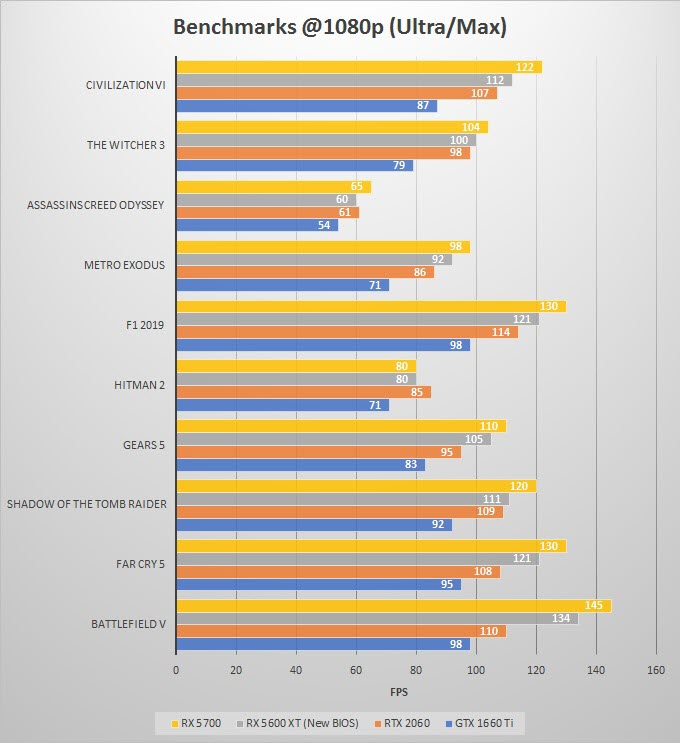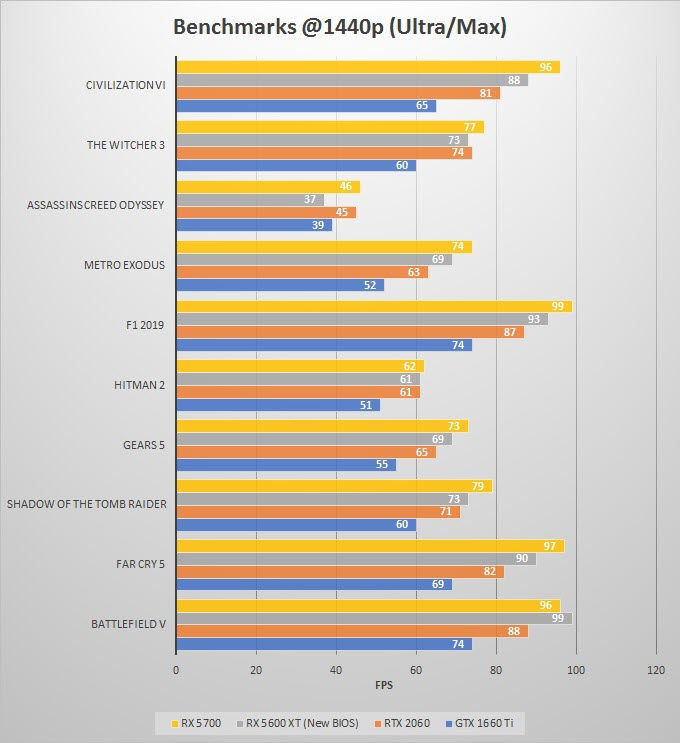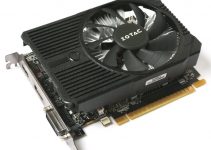The competition in the mid-range category graphics cards is becoming more and more competitive as both Nvidia and AMD are flooding this segment aggressively. The launch of the RX 5600 XT has made things more confusing for the majority of the mainstream gamers, who play mostly on 1080p at ultra settings, and sometimes at 1440p (with some graphics settings reduced). The major competitors of the RX 5600 XT are RTX 2060, GTX 1660 Ti, and GeForce GTX 1660 SUPER from Nvidia and even its bigger brother, which is Radeon RX 5700. So, if you are in the process of getting a mid-range or mainstream graphics card for gaming and are confused between these cards, then here I am going to compare them on various important parameters so that you can make an informed and wise decision.
 RX 5600 XT vs RTX 2060 vs GTX 1660 Ti vs RX 5700
RX 5600 XT vs RTX 2060 vs GTX 1660 Ti vs RX 5700
Here is a short and precise comparison between these cards based on their specifications, performance, features, power consumption, and pricing.
GPU Architecture
Radeon RX 5600 XT and RX 5700 are powered by RDNA GPU architecture and use the same Navi 10 GPU built on the 7nm manufacturing process. Also, both of them come with 2304 Stream Processors. On the other hand, GeForce GTX 1660 Ti and RTX 2060 use Turing GPU architecture, manufactured on the 12nm process. GTX 1660 Ti uses TU116 chip and comes with 1536 CUDA Cores, while the RTX 2060 uses the TU106 / TU104 chips and comes with 1920 CUDA Cores. You must note that even though both are Turing based graphics cards, they differ in certain capabilities. RTX 2060 is an RTX 20 series card and comes with RT Cores for Real Time Ray Tracing and Tensor Cores for AI & Deep Learning Super Sampling, while GTX 1660 Ti does not possess RT cores and Tensor cores.
Important Note: There are two versions of the RX 5600 XT with different Video BIOS (VBIOS). The one with updated or newer VBIOS has higher GPU clock speeds (Game/Boost) and higher memory speed. Moreover, it has slightly higher power consumption too.
Must Read: CUDA Cores vs. Stream Processors
| GTX 1660 Ti | RTX 2060 | RX 5600 XT | RX 5700 | |
| GPU Chip | TU116 | TU106 / TU104 | Navi 10 | Navi 10 |
| Manufacturing Process | 12nm | 12nm | 7nm | 7nm |
| CUDA Cores / Stream Processors | 1536 CUDA Cores | 1920 CUDA Cores | 2304 Stream Processors | 2304 Stream Processors |
| RT Cores | NA | 30 | NA | NA |
| Tensor Cores | NA | 240 | NA | NA |
| GPU Architecture | Turing | Turing | RDNA | RDNA |
Video Memory [VRAM]
The card with the fastest and most memory here is the Radeon RX 5700 which comes with 8GB GDDR6 memory, operates at 14 Gbps, has a 256-bit memory interface, and offers a bandwidth of 448 GB/s. Next, we have the RX 5600 XT which comes 6GB GDDR6 memory having a 192-bit interface. The reference or original RX 5600 XT has a memory speed of 12 Gbps, while the updated ones with newer Video BIOS have a memory speed of 14 Gbps, and it results in significantly higher memory bandwidth, which is 336 GB/s, compared to 288 GB/s for the reference model. RTX 2060 also comes with 6GB GDDR6 memory with a 192-bit interface, having a speed of 14 Gbps and bandwidth of 336 GB/s. The memory used in GTX 1660 Ti is 6GB GDDR6 which is 192-bit wide but operates at a slower speed of 12 Gbps and delivers a bandwidth of 288 GB/s, which is the same as the reference RX 5600 XT card with older VBIOS.
Must Read: GDDR6 vs GDDR5 vs HBM2 vs HBM Memory
| GTX 1660 Ti | RTX 2060 | RX 5600 XT | RX 5700 | |
| Memory Size | 6GB GDDR6 | 6GB GDDR6 | 6GB GDDR6 | 8GB GDDR6 |
| Memory Interface | 192-bit | 192-bit | 192-bit | 256-bit |
| Memory Speed | 12 Gbps | 14 Gbps | 12 / 14 Gbps | 14 Gbps |
| Memory Bandwidth | 288 Gbps | 336 Gbps | 288 / 336 GB/s | 448 GB/s |
Features
All of these graphics cards support DirectX 12, OpenGL 4.6, and Vulkan API and are VR-ready graphics cards. Also, they support dynamic refresh rate technologies (G-Sync for Nvidia & FreeSync for AMD) that help to prevent screen tearing in games for delivering smoother gameplay and eliminate stuttering. Here, RTX 2060 is the only card that supports Real-Time Ray Tracing and Deep Learning Super Sampling (DLSS) to enhance the visual quality in the supported games and make them look life-like.
On the other hand, Radeon RX 5600 XT and RX 5700 are the only cards to support the latest PCI Express Gen4 interface. They come with features like Radeon Image Sharpening, Radeon Boost, and Radeon Anti-Lag to enhance the graphics and gaming performance. All these graphics cards are also very capable for video editing tasks, and they support 4K H264 & H265/HEVC encoding and decoding.
| GTX 1660 Ti | RTX 2060 | RX 5600 XT | RX 5700 | |
| DirectX | 12 | 12 | 12 | 12 |
| OpenGL | 4.6 | 4.6 | 4.6 | 4.6 |
| Vulkan API | Yes | Yes | Yes | Yes |
| Bus Interface | PCIe 3.0 | PCIe 3.0 | PCIe 4.0 | PCIe 4.0 |
| SLI / CrossFire | NA | NA | NA | NA |
| Ray Tracing | NA | Yes | NA | NA |
| DLSS | NA | Yes | NA | NA |
| VR Ready | Yes | Yes | Yes | Yes |
| G-Sync / FreeSync | G-Sync & FreeSync | G-Sync & FreeSync | FreeSync | FreeSync |
Gaming Performance
Here are the gaming benchmarks of these graphics cards in popular AAA games at 1080p and 1440p resolution at ultra-graphics settings.


In the above benchmarks, you can see that Radeon RX 5600 XT beats RTX 2060 in most of the games and comes pretty close to the RX 5700 (in performance), which is a higher-priced card. GTX 1660 Ti is the slowest card here and does not stand a chance against the other cards.
Power Consumption
Here, the card that consumes the least amount of power is the GTX 1660 Ti. It is a very power-efficient card and has a TGP (total graphics power) of 120W. The next card with lower power consumption is the reference RX 5600 XT with an older BIOS, and after that, it is the RX 5600 XT with a newer BIOS. Even though both RTX 2060 and RX 5600 XT (updated VBIOS) have TGP of 160W, the RX 5600 XT is more efficient and consumes less power than the RTX 2060. The card that consumes the highest power is the RX 5700, which has a TGP of 180W, and requires a 600W PSU for its working.
| GTX 1660 Ti | RTX 2060 | RX 5600 XT | RX 5700 | |
| Power Consumption | 120W | 160W | 150W / 160W | 180W |
| Recommended PSU | 450W | 500W | 500W | 600W |
Pricing & Availability
When it comes to prices, then the cheapest card here is the GTX 1660 Ti ($279), and the priciest is the RX 5700 ($349), which is also the most powerful one. The price of RTX 2060 ($349) is higher than of RX 5600 XT ($279 to $289), but you may find RTX 2060 models like the EVGA RTX 2060 KO at around $300 or so. Most of the custom models of these cards from various AIBs do cost a little more than the base MSRP, and you can check the latest prices of these cards from below.
Check Radeon RX 5600 XT Price on Amazon
Check GeForce RTX 2060 Price on Amazon
Check GeForce GTX 1660 Ti Price on Amazon
Check Radeon RX 5700 Price on Amazon
RX 5600 XT vs RTX 2060 vs GTX 1660 Ti vs RX 5700 Specifications
| GTX 1660 Ti | RTX 2060 | RX 5600 XT | RX 5700 | |
| GPU Chip | TU116 | TU106 / TU104 | Navi 10 | Navi 10 |
| CUDA Cores / Stream Processors | 1536 CUDA Cores | 1920 CUDA Cores | 2304 Stream Processors | 2304 Stream Processors |
| GPU Architecture | Turing | Turing | RDNA | RDNA |
| Memory Size | 6GB GDDR6 | 6GB GDDR6 | 6GB GDDR6 | 8GB GDDR6 |
| Memory Interface | 192-bit | 192-bit | 192-bit | 256-bit |
| Memory Speed | 14 Gbps | 14 Gbps | 12 / 14 Gbps | 14 Gbps |
| Memory Bandwidth | 288 Gbps | 336 Gbps | 288 / 336 GB/s | 448 GB/s |
| Bus Interface | PCIe 3.0 | PCIe 3.0 | PCIe 4.0 | PCIe 4.0 |
| DirectX | 12 | 12 | 12 | 12 |
| OpenGL | 4.6 | 4.6 | 4.6 | 4.6 |
| Vulkan API | Yes | Yes | Yes | Yes |
| SLI / CrossFire | NA | NA | NA | NA |
| VR Ready | Yes | Yes | Yes | Yes |
| G-Sync / FreeSync | G-Sync & FreeSync | G-Sync & FreeSync | FreeSync | FreeSync |
| Power Consumption | 120W | 160W | 150W / 160W | 180W |
| Recommended PSU | 450W | 500W | 500W | 600W |
See also:
Final Thoughts
Well, if you are on a tight budget and looking for a graphics card that can handle 1080p gaming very well and can deliver 60 FPS on average in most of the games, then you should go for the GeForce GTX 1660 SUPER, which I have not covered in this comparison because it does stand a chance in the performance department against the RX 5600 XT and RTX 2060. Also, GTX 1660 Ti has become worthless because it loses out to RX 5600 XT and RTX 2060 badly and costs almost the same as RX 5600 XT.
Now regarding the RX 5600 XT, it is a very impressive card that is faster than RTX 2060 in most of the games and also costs less. Also, it comes very close to the performance of RX 5700, which is relatively expensive but has the advantage of extra 2GB VRAM, which can come in handy in demanding titles such as Red Dead Redemption 2. The main factor that goes against the RX 5600 XT is that some RX 5600 XT cards cannot be upgraded to the newer VBIOS, and this creates a lot of confusion about which RX 5600 XT to get. Also, even if the new VBIOS is available, then upgrading the graphic card VBIOS may not be everyone’s cup of tea, and it involves a bit of risk too. Regardless of all this, I must say that RX 5600 XT is a great option over the RTX 2060 and does offer a lot of value for the money you are paying.
(*This post may contain affiliate links, which means I may receive a small commission if you choose to purchase through the links I provide (at no extra cost to you). Thank you for supporting the work I put into this site!)
![Best Graphics Card for Video Editing & Rendering [4K & 1080p] Best Graphics Card for Video Editing & Rendering [4K & 1080p]](https://graphicscardhub.com/wp-content/uploads/2018/07/Adobe-Premiere-Touch-Edit-211x150.jpg)


Hi. Great article
Was wondering if you ever wrote on the RTX max Q?
Also any opinion on resellers of laptops such as
Hidevolution that customizes a laptop?
Thanks
Charles
No, I have not done that. I don’t have enough idea about Hidevolution and I recommend buying from the main seller only.
Hi Akshay,
I have an older motherboard which can only handle PCIE 3.. Will a rx 5700 work on a motherboard with pcie 3?
Yes, it will work with your motherboard but make sure you have a good 600W power supply.
Ryzen 5 3600
16GB 3200Mhz Ripjaws
Asus B450F MoBo
Galax RTX 2060 Super 8GB
500GB 860Evo SSD
Silverstone PF240 Liquid Cooler
Hi, this is my system Specs! I built this for Davinci Resolve 16 Studio for 4K workflow, Does this support 10bit Video output? and Can u recommend a Monitor with Good Color accuracy and 10bit 99% sRGB support? less than 30K Budget
Yes RTX 2060 can support 10-bit color using Nvidia Studio Drivers. For monitor, have a look at Acer Nitro 27-inch 1440p IPS Monitor (VG271U).
my pc
min biostar z97
ram 4*8 g ……32 gig bus 1300 ddr3
power 1200 w
cpu i7 4790k
i can use vga 2060 ?
yes you can
My monitor is hp… Reservation max 1920*1200 60mhz
No problem ?
no